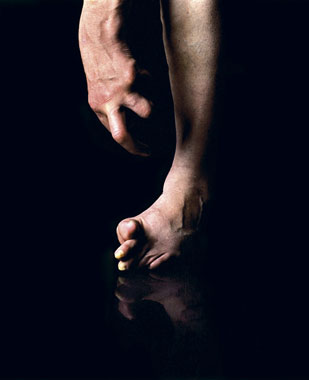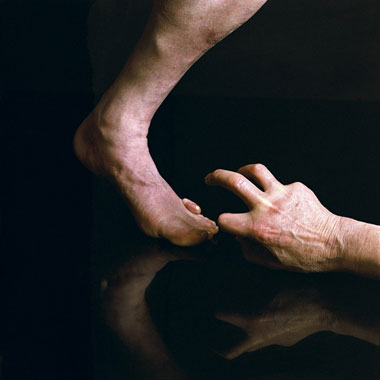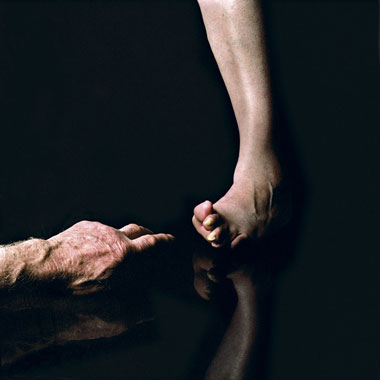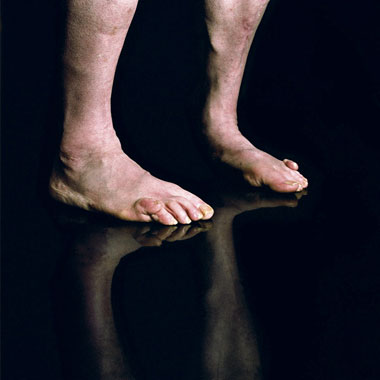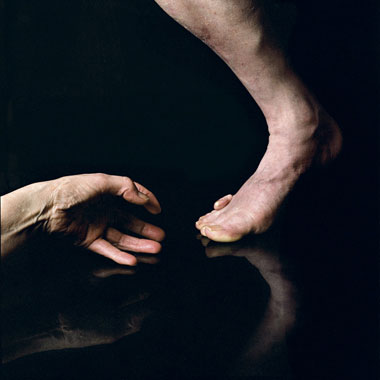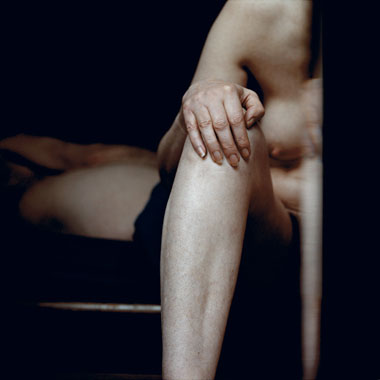Dr Slavka Sverakova has been in e-mail conversation with artist Kate Byrne, August – September 2005.
Slavka Sverakova : Your lens, Kate, is an enthusiastic intruder in private space. I recall that this has not always been the case, the earlier photographs are different. The question is how different, what is the dominant difference and how did the newer mode of work develop?
Kate Byrne : The earlier work, Exposure series and Trace series (1999), dealt with a playful engagement with the found object through the lens of a pinhole camera. I also used a 35mm camera and photographed through the bottom of handbags. In Exposure my experience of having had three handbags violently snatched from me was turned on its head by transforming the bag into both weapon and camera. The interior of the bag became a dark vacuum of space with one visible exit through the claw- or teeth-like structures that formed a sharp metallic zip.
The pinhole camera doubled as an apparatus for surveillance and voyeurism allowing the viewer to engage in a nonconclusive activity of speculation, interpretation and mental reconstruction. The work addressed the art object as if it was a kind of evidence. The viewer became an investigator, tracing a history of prior actions and motivations.
Trace suggested deeds or misdeeds and the images formed a patchwork of evidence.
For the past five years my photography has concentrated more on the relationship between physical boundaries and psychological transgression. At the start of the MFA course I began a series of self-portraits that questioned human consciousness about the ways women have been classified and evaluated. The portraits sought to challenge accepted norms of identity; they questioned what might or might not be a safe boundary when confronting the viewer with anatomical form. For me those ‘safe boundaries’ stretched their fences to include the sensual, the grotesque and the uncanny. Nevertheless my ‘safe boundaries’ insisted on anonymity and recognition of our vulnerable physicality.||5|
SS : While you enliven the surfaces of flesh by close ups and minute details – all in bright light – you still manage to veil identities. How important is this veiling – especially in relation to the vulgar obsession with celebrities in contemporary media images?
KB : Veiling of identities has been extremely important in the work in recent years. It is significant and evident in Arnolfini wife and Familiar . I have used the fragmented body enlarged beyond human scale. Unfamiliar angles or viewing positions have been frequently employed to introduce a sometimes disquieting enquiry on personal or internal battles between life and death. The fragmented bodies are both anonymous and androgynous. From the viewer’s point of view they are seldom comfortable. The intention is that the gaze becomes more intimately focused on the notion of skin, which in turn becomes more like a screen between the visible and the invisible. Due to the imposing scale, where each pore, hair and defect assumes an almost surreal quality, questions of sexuality become blurred. It becomes much more difficult to decipher whether or not the physical structure suggests the masculine or the feminine. Essentially then, what I am attempting to achieve is to transfer the idealised, abstract quality of commercialism and artificiality onto a very material level that questions the strange and unstable physicality that is our body.
SS : The dualities of visible-invisible, or masculine-feminine indicate the uncertainty of knowing a person. The fraudulent ‘knowing someone’ becomes even more slippery to grasp when your models are plants. They look as they do in the world; yet they forge a suspense that signals emotion (like loneliness). Do they connect the ordinary with the extraordinary, in the way life and death connect?
KB : The raw cabbage presented a potential to combine an idealized feminine with the mundane. If the image succeeded I felt it would provide a potent means of questioning the domestic and the abject. It would also question sexuality. The choice of the cabbage was deliberate. Having grown up on a farm in Limerick, cabbage was harvested and eaten at a vigorous daily rate. It constantly accompanied the successive plates of flat grey bacon on the after-school dinner plate. Later, when I placed the cabbage in front of the naked body, it immediately became suggestive of a corporal protrusion or womb-like structure. I had worked for two years in a Kenyan hospital during the early ’80s. In the course of this work I was present at dozens of caesarean sections and was struck by the resemblance of the womb to the cabbage. I saw the layers being peeled away and then gazed with curiosity and fascination at a life emerging. Yes, where the cabbage has been cut away or isolated, it recalls loneliness, a disappointment and possibly an anger or frustration, as in isolation both nature and nurture become exclusively incompatible. The ambiguity and the fragmentation guarantee that the images do not provide a safe resting place for self-indulgent musing.
The interpretation of the cabbage as an internal or womb-like organ, coupled with the deliberate introduction of the bizarre, confronts the viewer with images that seek to penetrate intimacy at both a psychological and a physical level. The granite surface and gentle mirrored ground provided by its reflection echo other thoughts of past history or place. This surface tends to suggest a degree of wavering between the masculine and the feminine through movement and pose. The reflected mirror with its abstract movement on the dark granite surface presents an exaggerated emphasis which is more persuasive than reality. Often the bizarre is re-enforced by images which are turned on their heads. The body appears almost claustrophobically doubled in a mirrored effect. When I juxtaposed my body with a raw egg, a startling optical effect occurred. I noticed that three of the six images which formed the narrative presented a pictorial illusion of little babies’ heads on each knee. It was accidentally conceived by the folding creases of skin around the knee cartilage. In these bizarre circumstances, I felt that the accidental optical illusion should be played out further. I subsequently gave the creased knee, with its bizarre little head, an elevated viewing position on the granite surface.
The primary motive of the work lies in a questioning of the aesthetics of beauty, what constitutes easy viewing and a fundamental need to further explore the simple but inevitable passage between birth and death.
SS : You move the ‘everyday’ into a philosophical/ ethical reflective thought through a passionate and merciless observation, even when you allow humour in. This in turn opens the way to authenticity. How do you relate this to the fashionable modes of citing, quotations, borrowings from other art?
KB : I am influenced by other art but I try not to borrow too much from it. For instance, the Arnolfini series (2001) originated from a study of the symbolism and imagery in Jan Van Eyck’s 1434 Arnolfini double portrait, where I found that the psychology behind the symbols and images within the portrait predominantly dealt with conception and the domestic. A poignant discovery came from an essay written by the English art historian, Craig Harbison. Harbison suggested that if the couple portrayed were actually Giovanni Arnolfini and his wife then they died childless. In the subsequent work, I used my own body to question the instability of sexual boundaries and to question the split or gap between the appearance of a symbol and the meaning behind it.
I don’t think one can positively say that a particular work is directly influenced by citings or borrowings, but I do think that work we absorb can leave a lasting impression, often on the subconscious more than the conscious mind, and it is that, coupled with a life’s experience that becomes the dominant force or voice. When I saw Jananne-Al Ani ‘s A loving man, I was deeply moved by the Iraq/Irish woman’s video installation that addressed and explored feelings of loss and rejection by mothers and daughters when separated from fathers and husbands because of culture clashes or war. She involves her mother and sisters in the installation and they repeat the same formulaic sentences, as if playing a memory game. In my work Familiar (2002), I created an installation by presenting seven large-scale (122 x 122 cm) photographs of the fragmented hands and feet of my aging parents. These hands and feet are engaged from one photograph to the next, setting up or producing a psychoanalytical reading of an aging couple who are alive, active and creating. They signify placidity, tension, togetherness and anxiety. The intimacy at both a psychological and physical level was disturbing yet strangely ‘familiar’. The work attempted to defeat our efforts to ignore or separate ourselves from the passage of time. Perhaps a more direct answer to the question could be that the artist’s awareness rather than the execution is the real influence.
Slavka Sverakova is a freelance writer on art.
.jpg)
.jpg)
.jpg)

